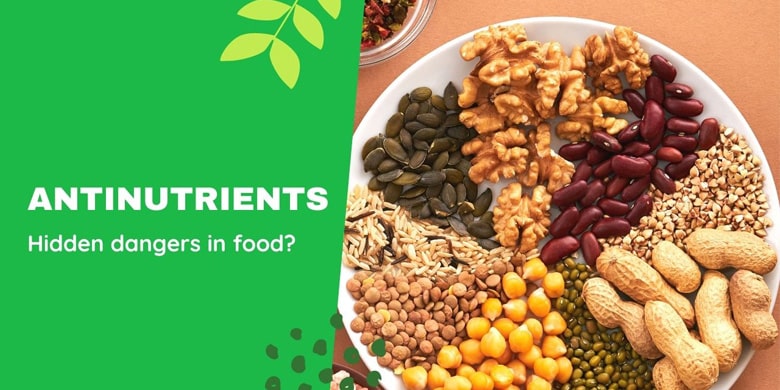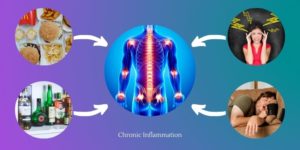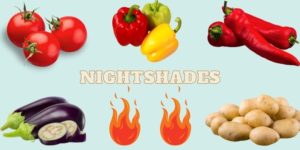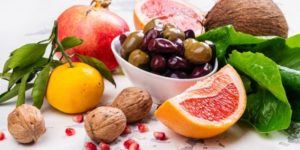Aren’t we all fans of natural foods like fruits, veggies, nuts, and seeds? Mother Nature is to be praised for providing us with delicious and nourishing foods.
But what about plants? Do plants like the fact that we eat them? Probably not. That’s why they developed various strategies to keep predators like bugs, insects, and animals at bay.
Plants create chemical substances known as antinutrients as one of their defense mechanisms against predators.
In this article, we will look at what are antinutrients, top antinutrient foods, how antinutrients affect the body, and much more. So, let’s get started.
What are Antinutrients?
Antinutrients are a collection of plant compounds found in plants that help them defend themselves against pests and predators.
When we eat foods that contain antinutrients, some of these substances prevent us from absorbing certain nutrients. That’s where the name “anti-nutrients” came from.
Now, plants contain a variety of these compounds, and not all of them operate as antinutrients, despite their name.
Even though the word ‘antinutrient’ sounds scary, antinutrients have both negative and positive health impacts in humans.
There are several types of antinutrients present in plant foods, such as:
Phytates (Phytic acid): Whole grains, legumes, and nuts are the common sources of phytates.
Lectins: Grains, legumes, nightshades, and most seeds are the sources of lectins.
Oxalate: Spinach, beet greens, swiss chard, most nuts, and seeds are high in oxalates.
Tannins: Tea, cocoa, beans, and most berries are high in tannins.
Saponins: Legumes, buckwheat, amaranth are good sources of this compound.
Phytoestrogen: Soybean and flax seeds are the most common sources of phytoestrogen, but minor amounts can also be found in several fruits and nuts.
Glucosinolates: most cruciferous vegetables including cabbage, cauliflower, broccoli, Brussels sprouts, and kale are high in this compound.
Foods High in Antinutrients
Grains and legumes are abundant in antinutrients, however, antinutrients can also be found in other foods.
The table below lists some examples of anti-nutrients some of the foods that are high in different types of antinutrients.
Phytic acid
| Sources | Amount |
|---|---|
| Whole grains (wheat, barley, rye, corn, oats) | 5000-7400mg /100g |
| Legumes and beans (Soybean, chickpeas, peanuts, pulses) | 386-714mg /100g |
| Nuts (Almonds, cashews, pistachio, hazelnut, brazil nuts, etc.) | 150-9400mg /100g |
Oxalates
| Sources | Amount |
|---|---|
| Grains (Wheat, barley, rye, corn, oats) | 35-270mg /100g |
| Nuts (Almonds, cashews, pistachio, hazelnut, brazil nuts, etc.) | 40-490mg /100g |
Lectins
| Sources | Amount |
|---|---|
| Nuts (Almonds, cashews, pistachio, hazelnut, brazil nuts, etc.) | 3700-14400 mcg /100g |
Tannins
| Sources | Amount |
|---|---|
| Tea | 370mg /100g |
| Green beans | 66mg /100g |
Saponins
| Sources | Amount |
|---|---|
| Legumes (Soybean, chickpeas, peanuts, pulses, etc.) | 106-170mg /100g |
Are Antinutrients Bad?
Antinutrients have both good and bad health effects.
For example: phytates, lectins, saponins reduce the bioavailability of several vitamins and minerals. But, they also help lower blood sugar, insulin responses, as well as cholesterol levels.
How Antinutrients Affect the Body?
The table below lists various antinutrients and their potential negative health effects.
| Antinutrient | Side Effects |
|---|---|
| Phytates | Inhibit the absorptions of minerals including zinc, calcium, magnesium, iron, phosphorous. Although it depends on various factors, phytates can indeed prevent up to 80% of a mineral from absorption. |
| Oxalates | Inhibit the absorption of calcium. Oxalates may increase the risk of kidney stone formation in some people. |
| Lectins | Can cause damage to the gut lining, leading to a leaky gut, which causes inflammation and food allergies. |
| Phyto-estrogens | Can increase estrogen levels. |
| Tannins | Can inhibit the absorption of iron. |
How to Reduce Antinutrients in Foods?
The good news is that most antinutrients in foods can be lowered using a few techniques.
Soaking: You can soak most beans, legumes, nuts, seeds, and grains in water for 6-12 hrs. before eating them or cooking with them. Soaking itself greatly reduces antinutrient content in food especially phytates and lectins.
Sprouting: When you drain the water and leave them for a few hours after soaking, it begins to sprout. Antinutrients reduce even more as a result of the sprouting process.
Fermentation: Various vegetables and some grains can be fermented. The fermentation process reduces antinutrients and increases the bioavailability of most nutrients.
Boiling: Antinutrients, such as oxalates and enzyme inhibitors greatly reduces when we boil the food.
# Antinutrients are known to be reduced when meals are boiled or cooked, but some research has revealed that other food preparation methods such as roasting, baking, and grilling can actually increase their level.
Takeaway
- Antinutrients are a group of plant chemicals that help protect plants from pests and predators.
- When we eat foods that contain antinutrients, some of them hinder nutrient absorption, which is why they’re called antinutrients.
- Not all antinutrients work in the same manner; some can cause different issues while others actually have health benefits.
- Phytates, lectins, oxalates, tannins, saponins, phytoestrogens are some of the most researched antinutrients.
- Grains, legumes, and nuts contain high amounts of antinutrients, but they can also be found in other foods.
- To make these foods more digestible and minimize antinutrient factors, soak them in water overnight, sprout them, or ferment them.
- Antinutrients can create problems for some people, but if you know how to eat them and how much to eat, they are normally safe for the majority of the population.
References: (source:1), (source:2), (source:3)
Also Read: Top Foods that are High in Polyphenols




